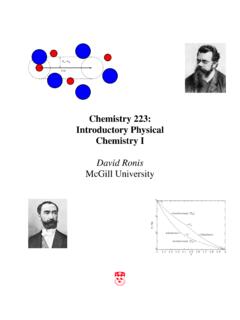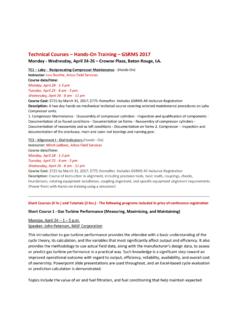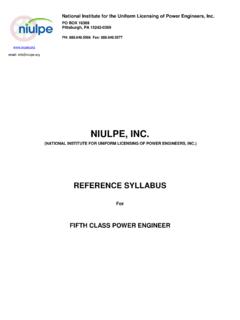Transcription of Chemistry 180-213B Introductory Physical Chemistry
1 Chemistry 180-213 BIntroductory PhysicalChemistryDavid Ronis 2002 McGill University-2-All rights reserved. Inaccordance with Canadian Copyright Law, reproduction of this material, in whole orin part, without the prior written consent the author is strictly truths are easy to understand once theyare discovered; the point is to in this grand book-I mean the universe-which stands contin-ually open to our gaze, but it cannot be understood unless one first learns to com-prehend the language and interpret the characters in which it is is writ-ten in the language of mathematics, and its characters are triangles, circles, andother geometrical figures, without which it is humanly impossible to understand asingle word of Galilei (1564 - 1642)-2-The Founders of ThermodynamicsJouleClausiusMaxwellCarnot KelvinGibbs-3-Table of Contents1.
2 General 52. Kubo : Founders of the first lawofthermodynamics .. : Whydowehav ewinter heating?.. : NicolasLeonard Sadi : AbsoluteTemperature .. : Onthe names of thermodynamic 113. Probability and 134. Maxwell-Boltzmann Distribution .. 165. Collision Rates, Mean Free Path, and Diffusion .. 226. Collision Theory of the Rate 277. Notes on the First LawofThermodynamics .. ZerothLawofThermodynamics .. SomeDefinitions .. Euler sTheorem, Partial Molar Quantities,.. Work and Heat in Energy in Classical TheFirst LawofThermodynamics.
3 368. EnthalpyCalculations: Chemical Reactions and Hess Law.. Measuring Reactions at Different Temperatures: Kirchoff sLaw .. Bond Energies .. Some Manipulations Involving Thermodynamic The relationship The Joule-Thompson 449. The Second LawofThermodynamics .. 4610. Carnot Engines, Efficiency, and The Second 4911. EfficiencyOfAReal Carnot 5412. The Clausius Inequality and the Mathematical Statement of the Second Law..5713. Systems With Variable Composition: The Chemical 5914. Exact Differentials and Maxwell 6115.
4 Thermodynamic Stability: Free Energy and Chemical Free Energy and EntropyofMixing .. Determination of Free Energies of Formation .. Determination of the Extent of a Coupled Temperature Dependence 7716. Eigenvalues and Thermodynamic 7917. EntropyofMixing: AStatistical View..8118. Phase 8419. Minimum and Maximum Boiling Azeotropes: The Gibbs-KonovalovTheorem .. 8820. Ideal Eutectic Phase 91-4-21. Capillary Rise and 9322. Problem Problem Set Problem Set Problem Set Problem Set Problem Set Problem Set Problem Set Problem Set Problem Set Problem Set Past Quiz I:1999.
5 Quiz I: Quiz I: Quiz II:1999 .. Quiz II:2000 .. Quiz II: Final Exam:1999 .. Final Exam:2000 .. Final Exam:2001 ..128-5-CHEMISTRY213B: Introductory Physical Chemistry GeneralInformationLectures: MWF9:30 - 10:30 Otto Maass 10 Course Web Site: (Username: chem213; Password: Gibbs)Professor: David RonisOffice: OttoMaass Room 426E-mail: , Physical Texts1. ,Chemical GordonM. Barrow, Physical ,Thermodynamics(Physics orientation, advanced)GradesThere will be approximately one problem set per week, twoquizes and a final quizes will be givenat18:00 on:Wednesday,February 6, 2002andWednesday,March 13, 2002(in Otto Maass 112)Completion of the homework is of the problems will not be graded, althoughone or twoproblems may be chosen at random and to the problem sets will beposted on the course web strongly encouraged to do the homework.
6 Theproblems will covermanydetails not done in class and will prepare you for the exams will involveextensiveproblem-solving and, in part, will contain problems from the homework!The typical studentwill not do well in (or evenpass) this course unless the problems are done. The course gradingscheme is:Winter Term 2001-2002 General Information-6- ChemistryCHEM 213 WGrade DistributionProblems 10%1st Quiz25%2nd Quiz25%Final 40%Winter Term 2001-2002 General Information-7- ChemistryCHEM 213 WCHEMISTRY213B: TENTATIVE OUTLINEDate Topic TextChapterLecture.
7 Thermodynamics,an overview2 Lecture properties of gases 2 Lecture properties of liquids and solids5 Lecture basis: Kinetic theory of gases 4 Lecture rates, effusion, and diffusion 30 Lecture 30 Lecture : thezeroth lawofthermodynamics 6 Lecture , Work, and Heat7 Lecture and irreversible changes7 Lecture First LawofThermodynamics: Energy 7 Lecture , Hess sLaw 7 Lecture Capacities, Kirchoff sLaw 7 Lecture EnthalpyChanges: BondEnthalpies 7 Wednesday,February 6, 2002: First QuizLecture Carnot Engine/Refrigerator8 Lecture Second LawofThermodynamics: Entropy8 Lecture 8 Lecture Third LawofThermodynamics: AbsoluteEntropies 9 Lecture for Stable Equilibrium.
8 Free Energies 10 Lecture Conditions (continued)10 Lecture Relations and equilibrium11 February 25 - March 1: STUDYBREAKL ecture equilibrium calculations 11 Lecture Equilibrium: The phase rule12 Lecture diagrams of Simple systems: Clapeyron and Clau-sius-Clapeyron equationsLecture Solutions13 Lecture properties 13 Wednesday,March 13, 2002: Second QuizLecture properties (continued)13 Lecture of volatile components14 Lecture and fractional distillation14 Lecture sLaw and calculations14 Lecture solutions17 Lecture : Electrochemicalcells 17 Lecture reactions and half-cell potentials17 Lecture equation and applications117 Lecture Information-8- ChemistryCHEM sDivertissementsFromThermodynamics(North Holland, 1976)Ryogo KuboUniversity of.
9 Founders of the first law of thermodynamicsIf a tomb of the Unknown Scientists had been built in the 1850 s, the most appropri-ate inscription would have been "In memory of the grief and sacrifice of those who fought torealize a perpetuum mobile". But the lawofconservation of energy,orthe first lawofthermody-namics, is associated primarily with three great names, Mayer,Helmholtz and Robert Mayer (1814-1878) was really a genius who was born in this worldonly with the errand to makethis great declaration. Hermann Ludwig Ferdinand von Helmholtz(1821-1894) gav ethis lawthe name "Erhaltung der Kraft" or "the conservation of energy".
10 LikeMayer,hestarted his career as a medical doctor but liveda glorious life as the greatest physiolo-gist and physicist of the Prescott Joule (1818-1889) worked overforty years to estab-lish the experimental verification of the equivalence of work and the three, Mayer was the first who arrivedatthis lawand the last whosework was recognized. His life was most dramatic. A lightening strokeofgenius overtook him, aGerman doctor of the age of twenty six, one day on the sea near Java when he noticed thatvenous blood of a patient under surgical operation appeared an unusually fresh red.







